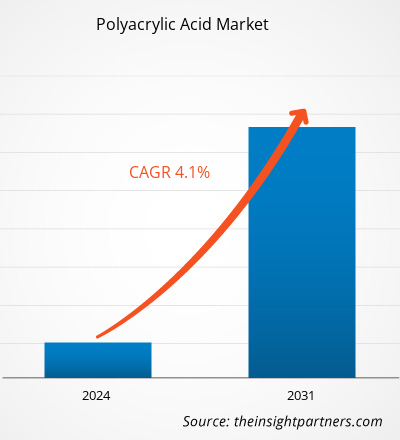2023 年聚丙烯酸市场价值为 24.3 亿美元,预计到 2031 年将达到 33.4 亿美元;预计 2023 年至 2031 年的复合年增长率为 4.1%。
市场洞察和分析师观点:
聚丙烯酸是一种合成的高分子量水溶性聚电解质。聚丙烯酸由丙烯酸聚合而成。聚合在溶剂中进行,例如水或水和异丙醇的混合物。市场参与者提供粉末和液体形式的聚丙烯酸。全球聚丙烯酸市场竞争激烈。聚丙烯酸用于各种终端行业,例如水处理、个人护理和化妆品、洗涤剂和清洁剂、皮革和纺织品、纸浆和造纸、油漆和涂料以及陶瓷。它是一种用途广泛的合成聚合物,具有各种工业应用,包括水处理、个人护理产品、纺织品、粘合剂、油漆和涂料以及纸浆和造纸。此外,预计聚丙烯酸在洗涤剂和清洁剂行业的采用将为预测期内聚丙烯酸市场增长提供丰厚的机会。
增长动力和挑战:
对水和废水处理活动的日益关注以及纸浆和造纸行业的需求不断增长,促进了聚丙烯酸市场规模的不断增长。许多欧洲国家正在朝着废水处理目标和敏感水系统的保护迈进。欧洲环境署 (EEA) 在 2021 年发布的数据显示,整个欧盟约 90% 的城市废水是根据欧盟废水处理指令收集和处理的。基于欧盟废水处理规则实施的国家分析表明,欧盟成员国正在大力执行这些规则,2016 年至 2018 年间合规率略有上升。全球造纸和纸浆行业正在增长,原因是电子商务行业不断扩大、对纸包装产品的需求不断增加以及对环保包装产品的需求不断增加等因素。美国、中国、德国、日本、芬兰和加拿大等欧洲、亚洲和北美国家是全球主要的纸浆和纸张生产国。在欧洲,纸张生产集中在北欧国家,包括芬兰、俄罗斯和瑞典。水处理和纸浆造纸行业的扩张推动了聚丙烯酸市场的增长。
原材料价格波动可能会对聚丙烯酸市场产生阻碍作用。供需缺口、自然灾害、政治不稳定、货币波动等因素都可能导致原材料价格波动。原材料价格波动使制造商难以规划和预算其运营。聚丙烯酸来源于化石。丙烯酸是生产聚丙烯酸的主要原料。影响丙烯价格的主要原因之一是全球经济格局。丙烯市场与石油和天然气行业密切相关,因为丙烯主要来自原油精炼或天然气液体裂解。石油产品和其他原材料价格上涨会抑制产品的利润率,对市场增长构成挑战。
定制此报告以满足您的需求
您可以免费定制任何报告,包括本报告的部分内容、国家级分析、Excel 数据包,以及为初创企业和大学提供优惠和折扣
-
获取此报告的关键市场趋势。这个免费样品将包括数据分析,从市场趋势到估计和预测。
报告细分和范围:
“2031 年全球聚丙烯酸市场分析与预测”是一项专业而深入的研究,重点关注全球市场趋势和增长机会。该报告旨在提供市场概述,并按形式、应用和最终用途行业对市场进行详细细分。市场在最近经历了高增长,预计在预测期内将继续保持这一趋势。该报告提供了全球聚丙烯酸消费的关键统计数据。此外,全球聚丙烯酸市场报告对影响全球市场表现的各种因素进行了定性评估。该报告还包括对市场主要参与者及其关键战略发展的全面分析。进行了多项分析,以确定关键驱动因素、聚丙烯酸市场趋势和有利可图的机会,进而有助于确定主要收入来源。
聚丙烯酸市场预测是根据各种二手和一手研究结果(如主要公司出版物、协会数据和数据库)估算的。此外,生态系统分析和波特五力分析提供了对市场的 360 度视角,有助于了解整个供应链和影响市场表现的各种因素。
节段分析:
全球聚丙烯酸市场根据形式、应用和最终用途行业进行细分。根据形式,市场分为粉末和液体。液体部分在 2023 年占据了聚丙烯酸市场的很大份额。与粉末相比,处理液体 PAA 溶液可降低粉尘暴露的风险。液体易与水和其他溶剂混合,可快速高效地制备浓度精确的溶液。与粉末相比,液体溶液不易结块,从而确保产品性能始终如一。但是,与液体溶液相比,粉末更易于处理和运输。它保质期长,在储存和运输过程中不易溢出或泄漏。PAA 粉末可轻松溶解在水中以形成具有所需浓度的溶液,为水处理、个人护理和纺织品等各个行业的应用提供多功能性。
根据应用,市场细分为分散剂、防垢剂、增稠剂、乳化剂、离子交换剂等。防垢剂部分在 2023 年占据了相当大的聚丙烯酸市场份额。PAA 可抑制不溶性矿物盐在表面的沉积,从而使其成为水处理中的重要化学品,可防止各种石油和天然气应用和工业清洁中的沉积物形成。PAA 广泛用于水处理,以防止水冷却系统、锅炉和反渗透膜中的结垢。它是一种经济高效、环境友好的解决方案,可防止和减轻矿物结垢的形成。
根据最终用途行业,聚丙烯酸市场细分为水处理、个人护理和化妆品、洗涤剂和清洁剂、皮革和纺织品、纸浆和纸张、油漆和涂料、陶瓷等。水处理部门在 2023 年占据了相当大的市场份额。PAA 可用作膜基水处理工艺(如反渗透和超滤)的澄清剂、分散剂和防垢剂。它通过抑制难溶盐在膜表面的沉淀来帮助防止膜污染和结垢。在过去的几年中,人们做出了许多努力来研究利用 PAA 消除水中的不良化合物。
区域分析:
该报告详细概述了五大主要地区的市场——北美、欧洲、亚太地区 (APAC)、中东和非洲 (MEA) 以及南美和中美。就收入而言,亚太地区在聚丙烯酸市场占据主导地位,2023 年的价值超过 8.5 亿美元。按国家/地区划分,亚太市场分为澳大利亚、中国、印度、日本、韩国和亚太其他地区。该地区对聚丙烯酸的需求一直在稳步增长,因为它是受重大工业化和城市化趋势推动的最快速增长的市场之一。需求的增长可以归因于其在各个行业的多种应用,包括个人护理、油漆和涂料、纺织品加工和水处理。所有这些因素都推动了亚太地区的聚丙烯酸市场。
预计到 2031 年,欧洲聚丙烯酸市场将达到约 7.5 亿美元。根据欧洲造纸工业联合会 2024 年 2 月发布的一份报告,纸浆总产量约为 3300 万吨,其中化学纸浆占 2023 年纸浆总产量的 79%。聚丙烯酸共聚物用作牛皮纸和纸板表面施胶的添加剂。此外,丙烯酸聚合物和共聚物用作涂料和纸张的分散剂、增稠剂、絮凝剂和共聚物乳液的水溶性剂。
聚丙烯酸市场区域洞察
Insight Partners 的分析师已详细解释了预测期内影响聚丙烯酸市场的区域趋势和因素。本节还讨论了北美、欧洲、亚太地区、中东和非洲以及南美和中美洲的聚丙烯酸市场细分和地理位置。

- 获取聚丙烯酸市场的区域特定数据
聚丙烯酸市场报告范围
| 报告属性 | 细节 |
|---|---|
| 2023 年的市场规模 | 24.3亿美元 |
| 2031 年市场规模 | 33.4 亿美元 |
| 全球复合年增长率(2023 - 2031) | 4.1% |
| 史料 | 2021-2022 |
| 预测期 | 2024-2031 |
| 涵盖的领域 |
按形式
|
| 覆盖地区和国家 |
北美
|
| 市场领导者和主要公司简介 |
|
聚丙烯酸市场参与者密度:了解其对业务动态的影响
聚丙烯酸市场正在快速增长,这得益于终端用户需求的不断增长,而这些需求又源于消费者偏好的不断变化、技术进步以及对产品优势的认识不断提高等因素。随着需求的增加,企业正在扩大其产品范围,进行创新以满足消费者的需求,并利用新兴趋势,从而进一步推动市场增长。
市场参与者密度是指在特定市场或行业内运营的企业或公司的分布情况。它表明在给定市场空间中,相对于其规模或总市场价值,有多少竞争对手(市场参与者)存在。
在聚丙烯酸市场运营的主要公司有:
- 阿科玛
- 阿什兰公司
- 巴斯夫
- 赢创工业集团
- 格伦瑟姆生命科学有限公司
- 日本触媒株式会社
免责声明:上面列出的公司没有按照任何特定顺序排列。

- 了解聚丙烯酸市场顶级关键参与者概况
行业发展和未来机遇:
根据公司新闻稿,以下是聚丙烯酸市场一些主要公司的最新发展情况:
- 2023 年,巴斯夫欧洲公司宣布在中国湛江的 Verbund 工厂开设生产综合体。该综合体包括丙烯酸丁酯 (BA)、丙烯酸冰片 (GAA) 和丙烯酸 2-乙基己酯 (2-EHA) 的生产设施。该公司透露了到 2025 年投产的计划,该综合体的年产能将达到约 400,000 公吨 BA 和 100,000 公吨 2-EHA。
2023 年,日本触媒株式会社在印度尼西亚万丹省芝勒贡市开设了年产 100,000 吨的丙烯酸工厂。据报道,该项目的总投资额约为 2 亿美元。
竞争格局和重点公司:
Arkema SA、Ashland Inc、BASF SE、Evonik Industries AG、Nippon Shokubai Co Ltd、Sumitomo Seika Chemicals Co Ltd、The Dow Chemical Co、The Lubrizol Corp、Shandong ThFine Chemical Co Ltd 和 Glentham Life Sciences Limited 是聚丙烯酸市场报告中介绍的主要参与者。全球市场参与者专注于提供高质量的产品以满足客户需求。
- 历史分析(2 年)、基准年、预测(7 年)及复合年增长率
- PEST和SWOT分析
- 市场规模、价值/数量 - 全球、区域、国家
- 行业和竞争格局
- Excel 数据集
近期报告
相关报告
客户评价
购买理由
- 明智的决策
- 了解市场动态
- 竞争分析
- 客户洞察
- 市场预测
- 风险规避
- 战略规划
- 投资论证
- 识别新兴市场
- 优化营销策略
- 提升运营效率
- 顺应监管趋势























 获取免费样品 - 聚丙烯酸市场
获取免费样品 - 聚丙烯酸市场